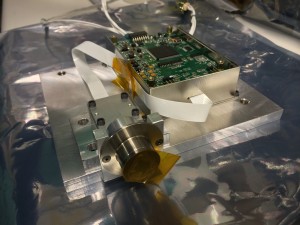MinXSS: Now in Science Mode!

The X123 mounted to a plate for flight in the SDO/EVE rocket. The plate covering the electronics has been removed to be measured, so you can see some of the internals. The detector itself is in the foreground, with a piece of kapton tape protecting the tiny, fragile aperture and beryllium filter.
Yesterday, early in the morning, we sent the command to put MinXSS in science mode. The main change in this mode is that the primary science instrument, the X123, is powered on and starts taking measurements. The X123 appears healthy, with its voltages and currents nominal; and thermal electric cooler keeping the detector at -50 ºC. Unfortunately, the instrument integrates for 10 seconds and the radio beacons every 9 seconds, which causes significant noise in the X123. We’d seen this on the ground but hoped that the problem was amplified by radio reflections inside the lab spaces we were always in when we noticed this behavior. It appears that even in wide open space, we still get noise. Once our bi-directional communication is fully locked down, we’ll reduce the beacon rate (or disable it entirely while in science mode) so that the x-ray spectra aren’t corrupted. This was already a part of our commissioning plan so there aren’t any surprises here really.
We’re continuing to get commands into he system intermittently. In total, the system has accepted 120 commands and rejected 50. Rejections happen when all the bits don’t get in properly. We’re getting beacons decoded more reliably but still not 100%. We’ve still got a list of improvements to make to the ground station and we’re continuing those between passes of MinXSS.
